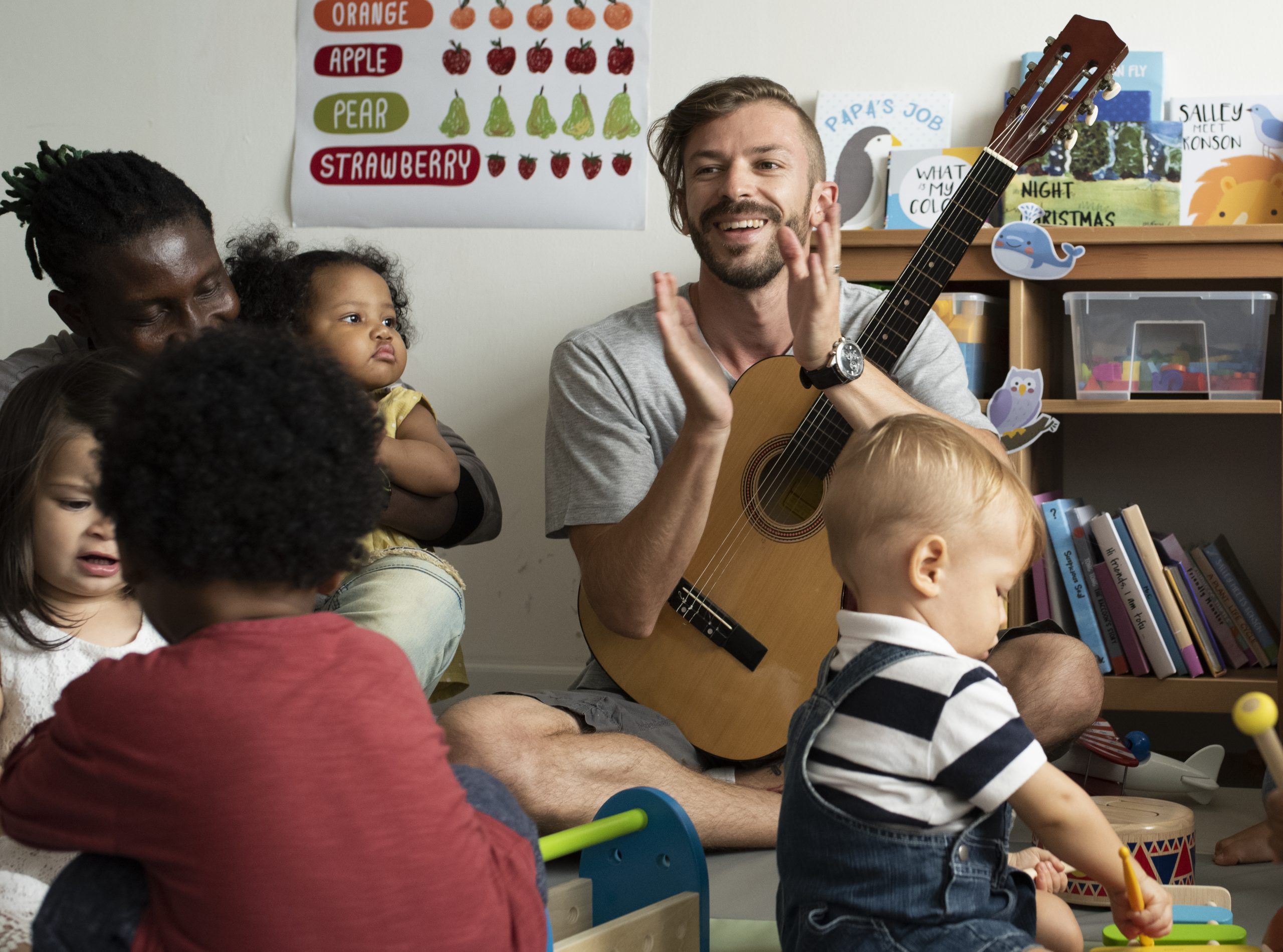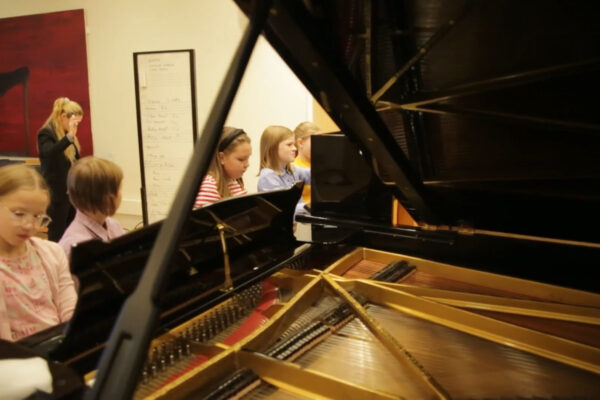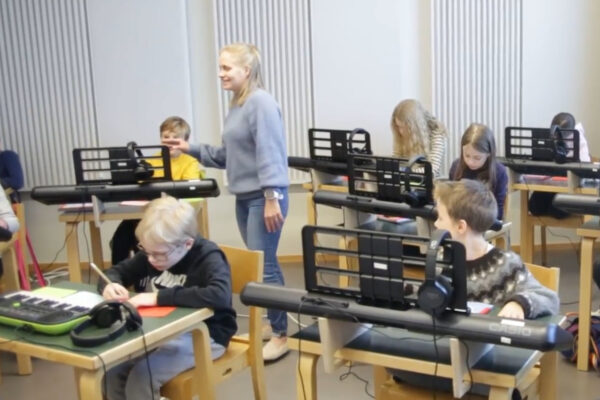
What happens in the video?
In the video we play games, improvise and make music together. The theme is seasons and we go through each one in the above-mentioned ways. In the background there is a plan for how the lesson should proceed but as we go along we are open to spontaneous changes. This video is addressed to cello and other instrument teachers. The content of the video is concentrated on instrument pedagogy.
How do you approach the children’s imagination?
Cello has four strings – four colours – that represent four characters moving from the highest to the lowest string. Blue stands for mother, orange for father, green for bear and red for elephant. This is a good way to activate the children’s imagination. From the very beginning the children are allowed and encouraged to play out their ideas on the instrument. For example when playing with the mother string we ask “What is the mother doing?” and the other players try to guess the answer. This way a connection is created to the child’s reality thus avoiding to play only ‘up bow’ and ‘down bow’ and instead make a connection to the child’s own environment, the child’s play. Music is full of imagination and playfulness.
Tell us about your own method

ColorStrings pedagogy is based on Kodály-method, after which Géza and Csaba Szilvay developed their pedagogic method for violin and cello in Helsinki. I was fortunate enough to study there myself at the time in the 70’s. The method has since then been adapted also for other instruments. I myself have used ColorStrings-method and spiced it with influences from other pedagogical directions, for example Suzuki and Montessori methods. Thus I ended up with my own creative child-oriented teaching method, that starts from visual expression and children’s singing and playing.
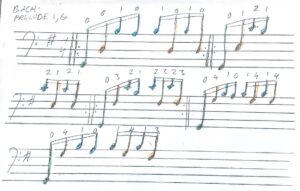
I have expanded the idea of colored notes to coloring printed music, for example from the books of Suzuki cello schools. Children want to color also printed music. When we play in different positions, the colors tell us which string to use.
Composing with children
The children are encouraged to draw out notes themselves and a pupil who still doesn’t know how to write or read, is surely capable of drawing.
 The first compositions of the children can be just splashes of color and different drawn out characters. It’s a story that has a direction – in other words ‘a composition’. This can be compared to graphically composed contemporary music. A colored area in the pupil’s composition represents which string the player is to use, the thickness of the area is directly proportional to the dynamics and the length to the duration of the piece. In addition the pupil might come up with his/her own special marks and effects. The advantage of this is that the pupil will be given the possibility to handle the instrument in many various ways from the beginning. The idea is to find out all the different sounds one can create from the instrument, for example how does a bird sound like.
The first compositions of the children can be just splashes of color and different drawn out characters. It’s a story that has a direction – in other words ‘a composition’. This can be compared to graphically composed contemporary music. A colored area in the pupil’s composition represents which string the player is to use, the thickness of the area is directly proportional to the dynamics and the length to the duration of the piece. In addition the pupil might come up with his/her own special marks and effects. The advantage of this is that the pupil will be given the possibility to handle the instrument in many various ways from the beginning. The idea is to find out all the different sounds one can create from the instrument, for example how does a bird sound like.
A safe learning environment
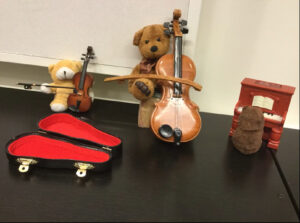 We inspire our playing by looking at pictures and toys, drawing or painting, dancing with music, percussion and other instruments. All teaching is child-oriented, we listen to the child and welcome him/her for who they are. It’s important to acknowledge each child’s weaknesses and strengths for example difficulty in concentrating. It’s good to give space for the child’s questions and curiosity, the possibility for them to search and find out things by themselves, encourage them to express the musical idea they have in their minds. If the child is used to using his/her imagination from the beginning of their instrument studies, it also works better when they are older and more advanced in their playing and follows them through adulthood. Perfoming and improvising doesn’t become so scary because the player’s self-esteem carries them through it.
We inspire our playing by looking at pictures and toys, drawing or painting, dancing with music, percussion and other instruments. All teaching is child-oriented, we listen to the child and welcome him/her for who they are. It’s important to acknowledge each child’s weaknesses and strengths for example difficulty in concentrating. It’s good to give space for the child’s questions and curiosity, the possibility for them to search and find out things by themselves, encourage them to express the musical idea they have in their minds. If the child is used to using his/her imagination from the beginning of their instrument studies, it also works better when they are older and more advanced in their playing and follows them through adulthood. Perfoming and improvising doesn’t become so scary because the player’s self-esteem carries them through it.
Often it’s easier first to sing and then to play a melody and it’s a good idea to find support for example from YouTube. The teacher’s job is to help with the notation. Learning shouldn’t feel painful and forced but a happy path, that winds to the destination – to the artist in you! The teacher provides the means, the student the ideas he/she wants to realize. A safe learning environment is vital during the lessons. The student brings all his background to the lesson with him/herself.
Welcome parents!
Parents are also welcome to the first instrument lessons, we teach them to play a few things and the parent and the child play together. The child is also allowed to teach the parent. The child is encouraged to voluntary learning, self-learning and he/she can make music at home with the parents.
What are the challenges?
The challenge is to get to know the child and his/her domestic background and create a safe interaction. The right approach is important for the learning experience to be safe and that there is a mutual trust between the teacher and the pupil. The challenge for the teacher is also to react quickly to different situations and moments and use upcoming reactions and events to lead the pupil in the right direction. It might become a challenge to burden the child with too many expectations, the student becomes restless, silent, locked-up. Often some children are ‘too kind’ to express their feelings, it’s important to try and provoke him/her to open up. In a safe environment the pupil can also tell if they are too tired.
 Teacher: Anna-Liisa Koponen, Lapland Music Institute
Teacher: Anna-Liisa Koponen, Lapland Music Institute
Anna-Liisa Koponen has been teaching cello at the Lapland Music Institute since 1991. She graduated from The Conservatory of Oulu. She specializes in baroque music and has studied also viola da gamba and various periodic cello instruments. She has studied Kodály- and Suzuki-methods which have influenced her personal teaching style. She has organized numerous collaboration projects with Drama School, Theater of Rovaniemi and Lapland Dance School.
